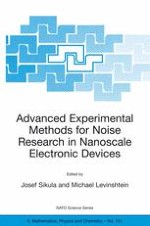2004 | OriginalPaper | Chapter
RTS in Quantum Dots and MOSFETs: Experimental Set-Up with Long-Time Stability and Magnetic Field Compensation
Authors : J. Sikula, J. Pavelka, M. Tacano, S. Hashiguchi, M. Toita
Published in: Advanced Experimental Methods For Noise Research in Nanoscale Electronic Devices
Publisher: Springer Netherlands
Included in: Professional Book Archive
Activate our intelligent search to find suitable subject content or patents.
Select sections of text to find matching patents with Artificial Intelligence. powered by
Select sections of text to find additional relevant content using AI-assisted search. powered by
This paper investigates the emission and capture kinetics of random telegraph signals (RTS) in Quantum dots and submicron MOSFET structures. Emphasis is laid on the signals showing a capture process which deviates from the standard Shockley-Read-Hall kinetics. The proposed model distinguishes between primary processes consisting in quantum transitions of electrons between traps and the conduction or valence band and secondary processes, consisting in current modulation. If the RTS noise sources are quantum transitions of electrons between a shallow trap and the conduction band then the primary process is one-dimensional and it coincides with the secondary process — current modulation. For deep traps the primary process is a two dimensional g — r process. It is shown in this paper how to distinguish experimentally between the one or two-dimensional primary processes by measuring the probability density of the occupation time in both current states. These long-time measurements require a very stable power source and active shielding of low frequency magnetic fields.
